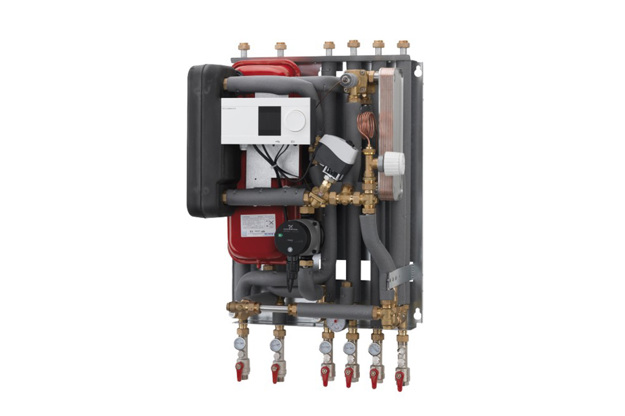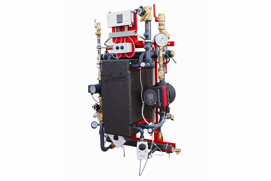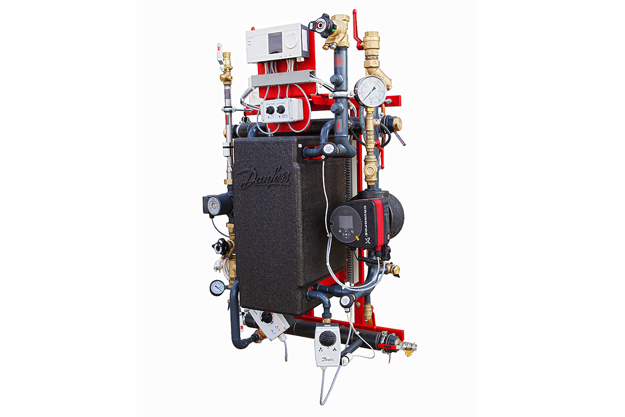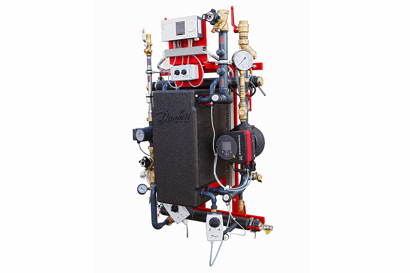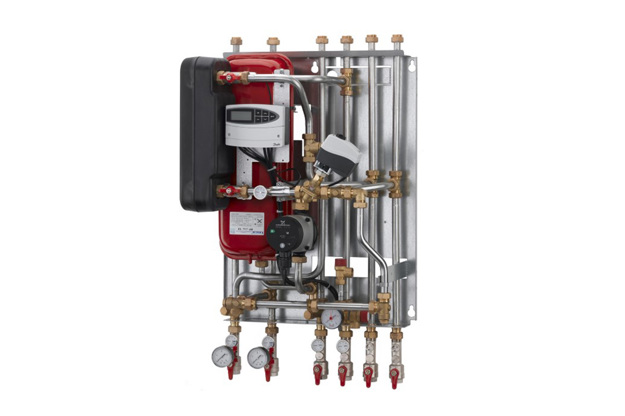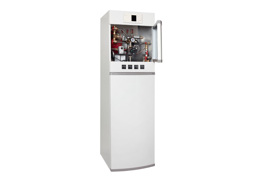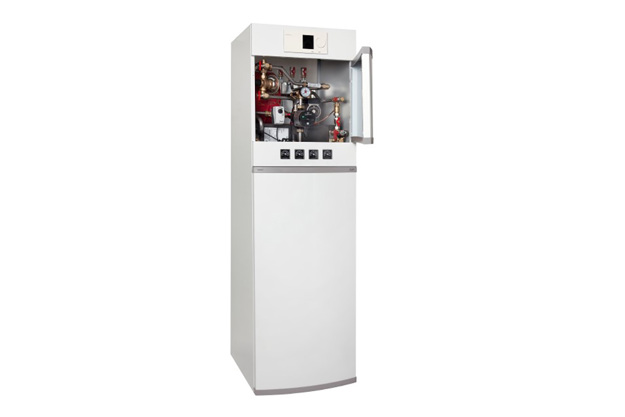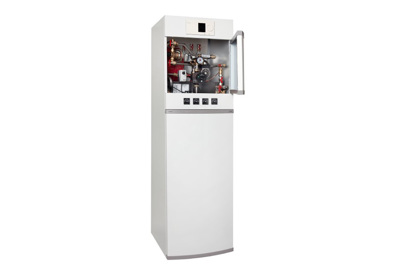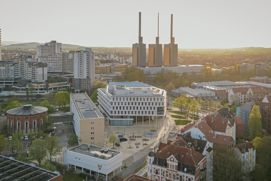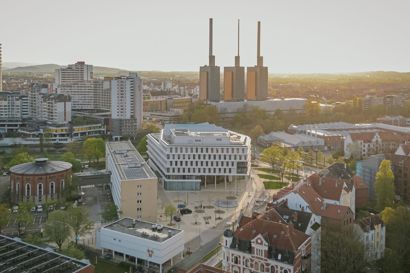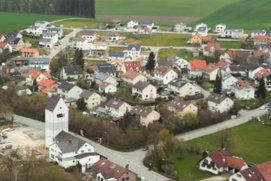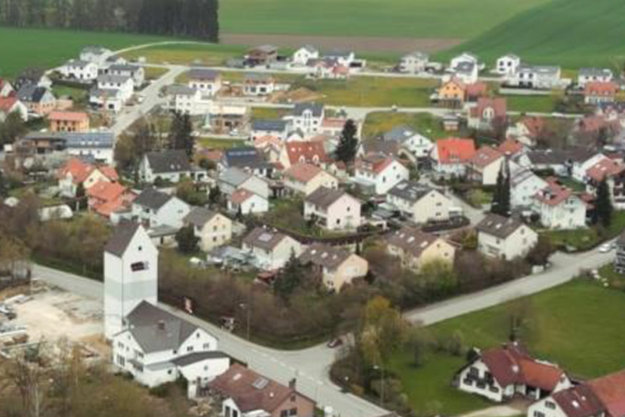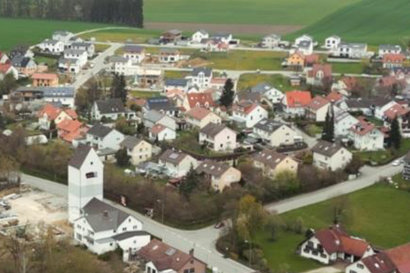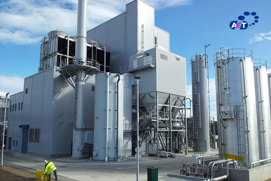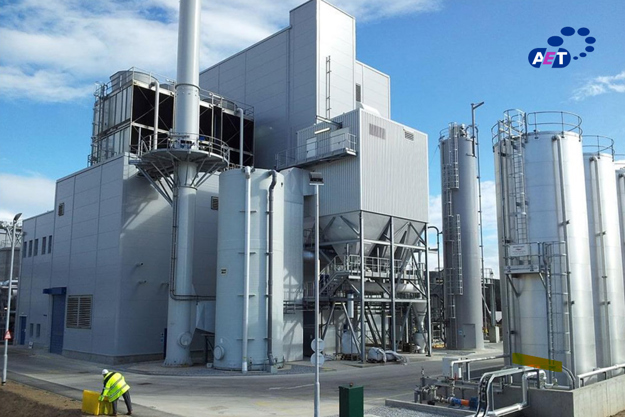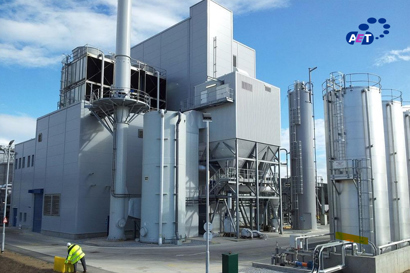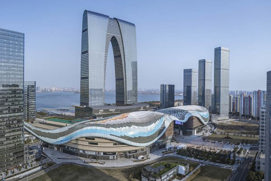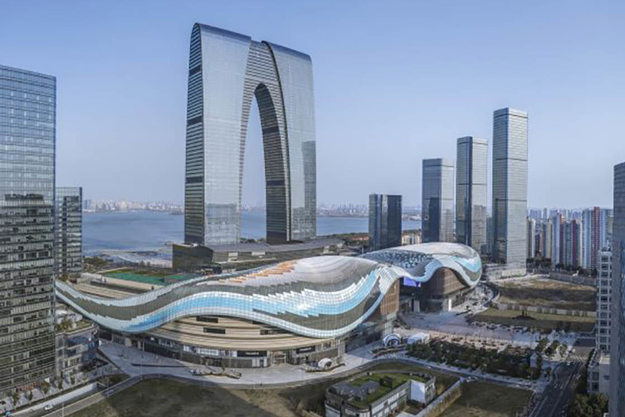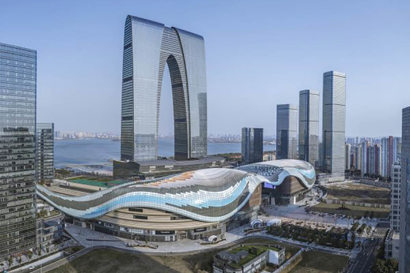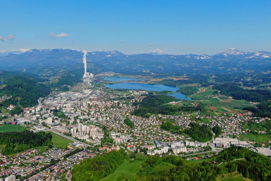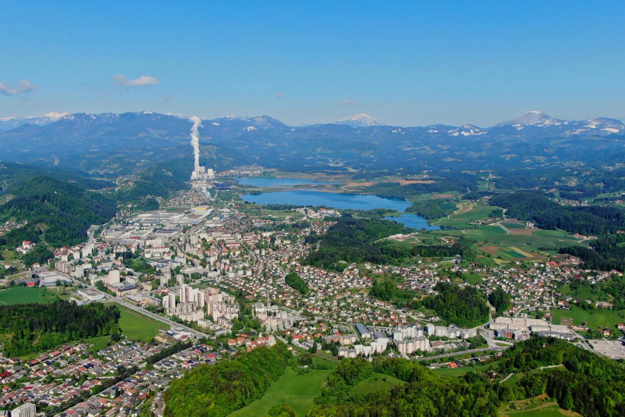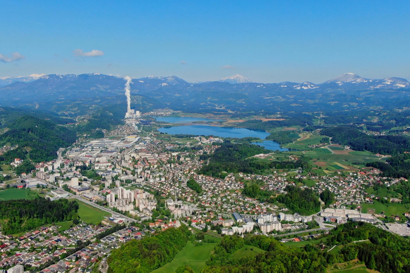An indirect substation is used when district heating network conditions, such as pressure and temperature, do not allow direct connection. When a substation is connected indirectly, a heat exchanger provides energy-efficient heat transfer. It also ensures that the primary network supply side and the secondary building installation side remain safely separated.
In this way, the building application works regardless of pressure or temperature variations in the district heating network (hydronic balancing) and is safe from pipe breaks or leaks.
Danfoss indirect substations are self-contained units that are generally wall-mounted. They can support single or multiple heating circuits, with or without domestic hot water production on the primary or secondary side.
These advanced solutions are also available with an electronic controller for weather compensation. This ensures easy and energy-efficient operation while simultaneously allowing central monitoring and energy consumption transparency.
Features and benefits
Advanced solutions available also with an electronic controller for weather compensation
Indirect substations with Micro Plate™ heat exchangers provide energy efficient heat transfer

Smaller, lighter, more efficient: Danfoss' compact substation DSA1 Mini
Learn how the station is installed, as well as tips and tricks for commissioning and maintenance.
Product range
-
if (isSmallPicture) {


 Indirect heating and domestic hot water
Indirect heating and domestic hot waterA substation for indirect heating has a heat exchanger separating the primary flow from the secondary flow. Indirect substations are recommended for PN16-networks and higher pressure classes.
-
if (isSmallPicture) {


 DSA - Danfoss Station Advanced Compact
DSA - Danfoss Station Advanced CompactFind more technical information about DSA - Danfoss Station Advanced Compact.
-
if (isSmallPicture) {


 Indirect heating
Indirect heatingA substation for indirect heating has a heat exchanger separating the primary flow from the secondary flow. Indirect substations are recommended for PN16-networks and higher pressure classes. Substations in this category are normally supplied with connection pipes for a domestic hot water cylinder on the primary side for the fitted constructions, and on the secondary side for the welded constructions.
-
if (isSmallPicture) {


 Indirect or direct heating and domestic hot water cylinder
Indirect or direct heating and domestic hot water cylinderSubstations for indirect heating have a heat exchanger separating the primary flow from the secondary flow. Indirect substations are recommended for PN16 networks and higher pressure classes. Substations for direct heating have no heat exchanger separating the primary flow from the secondary flow and are recommended for maximum PN10 or PN6 networks. The domestic hot water is heated in a cylinder by the district heating water flow in a coil within the cylinder.
-
if (isSmallPicture) {


 DSP MOD@ substation
DSP MOD@ substationDSP stands for ‘Danfoss Substation Prefabricated’, highlighting the fact that you get a substation that is easy to install and that complies with 90% of the typical district heating network technical connection requirements. MOD@ stands for ‘modular and digital’, meaning you get a substation that’s flexible, easy to configure and works seamlessly with our digital district heating network product portfolio.
Documents
Tools and apps
Case stories
-
if (isSmallPicture) {


 Roll-out in 50,000 housing units: enercity AG optimizes district heating supply with Leanheat® Building
Roll-out in 50,000 housing units: enercity AG optimizes district heating supply with Leanheat® BuildingThe AI-powered software Leanheat® Building helped Hanover’s district heating utility systematically integrate the buildings side of the network and achieve a 5-10% reduction in energy consumption and a 20% reduction in peak loads.
-
if (isSmallPicture) {


 Successful transition from oil boilers to a local heating network in Eurasburg
Successful transition from oil boilers to a local heating network in EurasburgIn the Wittelsbacher Land near Augsburg the local network in Eurasburg supplies heat to 80 buildings using a wood chip heating system. Danfoss’ substations ensure efficient heating in all building types, and its modern SCADA solution enables remote system monitoring and management.
-
if (isSmallPicture) {


 DrivePro® Lifecycle Services secure maximum uptime for Rothes CoRDe
DrivePro® Lifecycle Services secure maximum uptime for Rothes CoRDeSCOTLAND: The Rothes CoRDe plant, a biomass-fired combined heat and power (CHP) plant, ensured maximum uptime thanks to several DrivePro® Lifecycle Services.
-
if (isSmallPicture) {


 Willhem AB and Danfoss AB takes the energy optimization in residential properties to the next level
Willhem AB and Danfoss AB takes the energy optimization in residential properties to the next levelGOTHENBURG, SWEDEN & HELSINKI, FINLAND – This heating season, European energy prices are expected to rise to record levels. One of the largest Swedish professional building owners, Willhem AB, has taken a proactive approach to cutting costs and reducing greenhouse gas emissions. Willhem has signed an agreement with Danfoss to implement the Leanheat Building software starting with 6,500 apartments.
-
if (isSmallPicture) {


 Pipe tracing in 600 Suzhou apartments China
Pipe tracing in 600 Suzhou apartments ChinaSuzhou city was founded in 500 BC. is nowadays a major city located in the south-eastern Jiangsu Province of East China, about 100 km (62 mi) northwest of Shanghai. It is a big economic center and local point of trade and commerce, and the second largest city in the province, after its capital Nanjing.
-
if (isSmallPicture) {


 Improved hydronic balancing of the district heating network in Slovenia
Improved hydronic balancing of the district heating network in SloveniaThe Saleska Valley district heating network is the second largest network in Slovenia, dating back to 1959. Since then, the demands have changed significantly and have challenged the hydronic balancing of the system which was optimized with new intelligent controllers Virtus.



